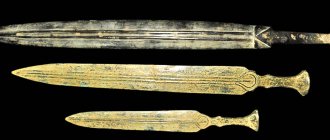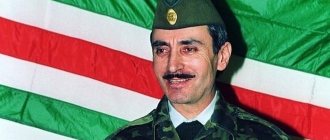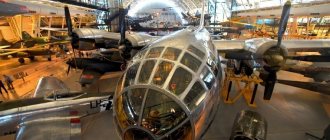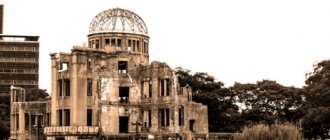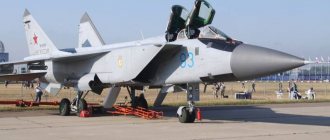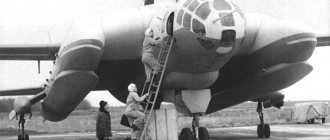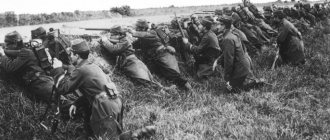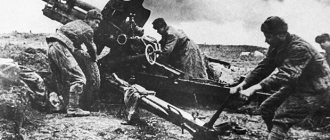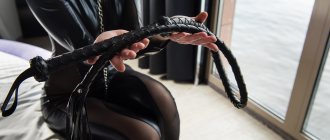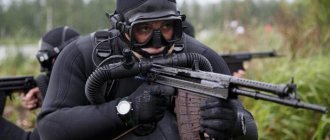The atomic bombings of Hiroshima and Nagasaki, carried out on August 6 and 9, 1945, are the only two examples in the history of mankind of the combat use of nuclear weapons.
The US military dropped two atomic bombs on the Japanese cities of Hiroshima and Nagasaki , killing more than 200,000 people.
In this article we will look at the causes and consequences of this terrible tragedy of the 20th century.
Japan at the end of World War II
As you know, Nazi Germany capitulated on the night of May 9, 1945. However, since Japan was an ally of Nazi Germany, the countries of the anti-fascist coalition declared war on it.
Within a month, as a result of fierce fighting, the Japanese were forced to leave Indochina and Indonesia. An interesting fact is that on July 26, China, Great Britain and America presented an ultimatum to the Japanese, which was subsequently rejected.
At this time, the Soviet Union also officially declared war on Japan. Less than a month later, Soviet troops completely defeated the enemy army. As a result of this, the disputed Kuril Islands and South Sakhalin became part of the USSR (see interesting facts about Sakhalin).
Prerequisites for the use of atomic weapons
Long before the events described above, in the fall of 1944, the leaders of the United States and Great Britain discussed the issue of the possible use of atomic bombs against Japan.
From that moment on, the famous Manhattan Project was launched, which resulted in the creation of super-powerful nuclear weapons.
There was no need to bomb
Alas, one should not confuse “defeat” and “surrender.”
Japanese leaders stubbornly refused to admit defeat, much less surrender. In addition, Japan had a long tradition of killing those politicians who prevented the military from ruling the country.
Tokyo was burned back in March 1945 - “the Japanese do not surrender.” They also burned almost all cities larger than forty thousand inhabitants - again, “they don’t give up.”
Results of conventional bombing - post-war scheme
Large Japanese ships were sunk or turned into a pile of scrap metal - “they don’t give up.” In the Pacific Ocean, the Americans took island after island - “they don’t give up.”
Japanese diplomats in the USSR reported back in May about the massive transfers of the Red Army to the east - Tokyo did not even understand this hint.
According to the United States, in the summer Japan had about five million soldiers, that is, there were still many reserves for the fight. The Potsdam Declaration of the United States, Great Britain and China on July 26, 1945 demanded surrender, otherwise there would be "the inevitable and final destruction of the Japanese armed forces, the equally inevitable complete devastation of the Japanese metropolis." On July 28, Japanese Prime Minister Baron Suzuki announced that the Japanese were ignoring the declaration.
And propaganda called on one hundred million Japanese to die for the emperor.
On July 29, a Japanese submarine sank the heavy cruiser Indianapolis, killing almost a thousand sailors.
And there were still thousands of planes left for kamikazes.
It was possible, of course, to land in Japan itself - but, according to US plans, not earlier than November 1945. What was left to do?
Reasons for the bombing of Hiroshima and Nagasaki
After the end of the war, the United States became the sole owner of nuclear weapons. Wanting to show their military power to the Soviet Union, they began to develop a project for a future bombing.
Nuclear mushroom over Hiroshima (left) and Nagasaki (right)
Japan was in this regard an ideal target for a strike, since, despite its defeats at the front, it was not going to capitulate.
According to the official US version, they dropped atomic bombs on Hiroshima and Nagasaki only because they did not want to sacrifice the lives of their own and allied soldiers in the event of a land invasion of Japan.
In their opinion, the bombing of Hiroshima and Nagasaki was the only way to quickly end the military conflict.
However, this is hardly true, since Winston Churchill, shortly before the Potsdam Conference, claimed that, according to Joseph Stalin, the Japanese want to establish a peaceful dialogue with the countries of the anti-fascist coalition.
Therefore, why attack a country that intends to negotiate?
However, apparently, the Americans really wanted to demonstrate their military potential and show the whole world the weapons of mass destruction that they have.
Japan was the ideal target for this terrible demonstration.
How it all began
The history of the project began with a letter, as it is commonly believed that the author of the letter was Albert Einstein. In fact, four people participated in writing this appeal. Leo Szilard, Eugene Wigner, Edward Teller and Albert Einstein.
In 1939, Leo Szilard learned that scientists in Nazi Germany had achieved stunning results on the chain reaction in uranium. Szilard realized how powerful their army would become if these studies were put into practice. Szilard also realized the minimality of his authority in political circles, so he decided to involve Albert Einstein in the problem. Einstein shared Szilard's concerns and composed an appeal to the American president. The appeal was written in German; Szilard, together with the other physicists, translated the letter and added his comments. Now they are faced with the issue of transmitting this letter to the President of America. At first they wanted to convey the letter through the aviator Charles Lindenberg, but he officially issued a statement of sympathy for the German government. Szilard was faced with the problem of finding like-minded people who had contacts with the President of America, and this is how Alexander Sachs was found. It was this person who handed over the letter, albeit two months late. However, the president’s reaction was lightning fast; a council was convened as soon as possible and the Uranium Committee was organized. It was this body that began the first studies of the problem.
Atomic bomb baby photo
Here is an excerpt from this letter:
Recent work by Enrico Fermi and Leo Szilard, whose manuscript version caught my attention, leads me to believe that elemental uranium may become a new and important source of energy in the near future [...] has opened up the possibility of realizing a nuclear chain reaction in a large mass of uranium, which will generate a lot of energy […] thanks to which you can create bombs ..
October 19, 1939
Selecting targets for an atomic strike
Having decided to use atomic weapons, the Americans formed a special committee. Committee members were to select Japanese cities on which bombs would subsequently be dropped. The main criteria when choosing goals were:
- Mandatory presence of civilian objects around the selected target;
- The high significance of the object, the destruction of which would cause a great resonance in society;
- Cities must not have been damaged by previous bombings for the destructive power of atomic weapons to be accurately assessed;
- The destruction of the selected object should entail not only economic losses, but also psychological ones.
Potential cities for bombing
Potential cities targeted for bombing included Kyoto, Hiroshima, Yokohama and Kokura. In these four megacities, military enterprises were located, as well as industrial facilities that played an important role in the country's economy.
There is an opinion that Kyoto was originally supposed to be one of the two cities, but US Secretary of War Stimson rejected this proposal. He explained this by the fact that Kyoto had many different attractions and historical monuments.
An interesting fact is that the bombings of Hiroshima and Nagasaki were not seriously considered by the commission members. More precisely, the second city attacked was supposed to be Kokura, but ultimately the atomic bombs were dropped on Hiroshima and Nagasaki.
Bombings of Hiroshima and Nagasaki
Before the bombing of Hiroshima and Nagasaki, the Americans engaged in careful planning. Within a few weeks, the US BBC 509th Airlift Group was reassigned to Tinian Island.
The preparations took place in extreme secrecy. On July 26, an atomic bomb called “Baby” was delivered to Tinian, and 2 days later the main parts of the second bomb, “Fat Man,” arrived.
After this, the US military leadership signed an order authorizing nuclear bombing. Now the Americans could only wait for suitable weather to begin the destruction of Hiroshima and Nagasaki.
A little about the past
The history of Hiroshima dates back to ancient times. Even in the period of more than 2 thousand years BC. On the territory of this modern city there were sites of primitive tribes. But only in the middle of the 16th century, the Japanese samurai Mori Motonari, under his leadership uniting the entire population of the Chugoku region, founded the settlement of Hiroshima on the shores of the bay, built a castle and made this place the center of his possessions. Over the next two centuries, one ruling family was replaced by another.
During the 19th century, settlements near the castle grew rapidly, and the area received city status. Since the beginning of the 20th century, Hiroshima has become the center of the General Staff of the Japanese Armed Forces, the base of the Imperial Navy and even the seat of the Parliament. Gradually, Hiroshima turned into one of the largest political and administrative centers of Japan.
The city of Nagasaki was founded by the samurai ruler Omura Sumitada in the second half of the 16th century. Initially, this settlement was an important trading center where merchants from different countries arrived. Many Europeans, admired by the beauty of Japanese nature, authentic culture and great economic prospects, took root there and remained to live. The city developed at a rapid pace. By the middle of the 19th century it was already the largest port of international importance. By the time the atomic bomb fell on Hiroshima, followed by the death of hundreds of thousands of innocent Japanese, Nagasaki was already the stronghold of the Japanese steel industry and the center of shipbuilding.
Developed infrastructure, the location of the main shipbuilding and automobile manufacturing plants, weapons and steel production, dense buildings, these factors met all the conditions that the US military put forward for the proposed facility for testing the destructive effect of an atomic bomb. Like the city of Hiroshima, tragedy struck Nagasaki in the late summer of 1945.
Bomb on Hiroshima
The first atomic bomb, called “Baby,” was dropped on Hiroshima on August 6, 1945. Before takeoff, the crew members who had the “honor” of dropping the bomb were confident that they were doing the right thing and doing a good deed for all mankind.
On the left is Major Thomas Ferebee, who dropped the bomb on Hiroshima. On the right is Captain Kermit Behan, who dropped the bomb on Nagasaki.
Interestingly, on the eve of the flight, the pilots even visited the temple. After this, they received an ampoule of potassium cyanide in case they were shot down and captured.
When the pilots boarded the B-29 bomber, which had “Baby” on board, and gained the required altitude, 3 more reconnaissance aircraft took off with them.
Their task was to escort B-29s and also monitor weather conditions. In addition, they had special photographic and video equipment on board, which was supposed to capture the consequences of the explosion.
The flight went well enough, but as we got closer to Japan, tension increased. The weather remained clear and calm.
An interesting fact is that the Japanese did not notice the deadly American planes, which would soon wipe out Hiroshima along with all its inhabitants.
When the B-29 bomber was over Hiroshima at an altitude of about 9 km, a bomb was dropped into the very center of the city.
The time she fell was about 45 seconds. Once at an altitude of 500-600 meters from the ground, “Baby” exploded, as planned.
Photo showing only a few concrete and steel buildings and bridges remaining, September 5
To date, documentary footage of the explosion has been preserved. On them you can see a nuclear mushroom, which was visible at a distance of more than 600 km.
There were 24 of them
The crew of the Enola Gay during the bombing on August 6th included 12 people, and the crew of the Boxcar on August 9th included 13 people. The only person who participated in both bombings was anti-radar specialist Lieutenant Jacob Beser . Thus, a total of 24 American pilots took part in the two bombings.
The crew of the Enola Gay included : Colonel Paul W. Tibbets, Captain Robert Lewis, Major Thomas Ferebee, Captain Theodore Van Kirk, Lieutenant Jacob Beser, US Navy Captain William Sterling Parsons, Second Lieutenant Morris R. Jeppson, Sergeant Joe Stiborik, Sgt. Robert Caron, Sergeant Robert Shumard, Cryptographer First Class Richard Nelson, Sergeant Wayne Dusenberray.
The crew of the Boxcar included : Major Charles Sweeney, Lieutenant Charles Donald Albury, Lieutenant Fred Olivi, Sergeant Kermit Behan, Corporal Ibe Spitzer, Sergeant Ray Gallagher, Sergeant Edward Buckley, Sergeant Albert Dehart, Staff Sergeant John Kucharek, Captain James Van Pelt, Frederick Ashworth, Lieutenant Philip Barnes, Lieutenant Jacob Beser.
Theodore Van Kirk was not only the last living participant in the bombing of Hiroshima, but also the last living participant in both bombings - the last of the Boxcar crew died in 2009.
Boxcar crew. Photo: Commons.wikimedia.org / Original uploader was Cfpresley at en.wikipedia
Bomb on Nagasaki
As mentioned above, initially the second bomb was planned to be dropped on Kokura, and not on Nagasaki. However, due to weather conditions, appropriate changes have been made.
Ruins of Nagasaki after the atomic bombing
When the American bomber flew over Kokura, the target was practically invisible due to heavy clouds. Then the leadership gave the order to bomb the “spare” city, which turned out to be Nagasaki.
On the morning of August 9, an American B-29 bomber took off, carrying the Fat Man atomic bomb.
The commander of this operation was Major Charles Sweeney, who subsequently opened the bomb bay.
Survivors of the atomic bombing of Nagasaki among the ruins, amid raging fire, August 9
Interestingly, the local stadium became the reference point for the reset. But fortunately Nagasaki was lucky, as the bomb fell far from its intended target. Thanks to this, the number of victims was much less than the Americans had planned.
Major Sweeney's Flying Circus
As Helen Bradbury, a historian of the Manhattan Project and the daughter of one of the Los Alamos physicists, said, halfway through the journey the crew of the Freight Train almost aged 30 years.
While the car was traveling through a monsoon storm surrounded by lightning, the bomb decided to spontaneously trigger the countdown mechanism to explode.
In the accelerating blinking of the red light, the technicians managed to... get pretty scared. After ten minutes of chilling horror, they realized: when setting up the bomb, some slob had mixed up two wires.
The error was corrected. They kept an eye on the bomb until it was dropped.
Over Yakushima, the Freight Train met the Artist. But there was no trace of “Big Stink” with photo and film equipment.
Because there was a mess going on with him too.
The crew commander, Major Hopkins, already before takeoff, threw Dr. Serber out of the plane, who absent-mindedly forgot his parachute. Already in flight it became clear that only this same doctor knew how to handle the equipment.
And now the strict Major Hopkins had to literally learn to take photographs and videotape on the fly.
While the crew commander, with strong Anglo-Saxon expressions, was learning the basics of photography, “Stinky” managed to climb three kilometers higher than planned. Instead of the narrow circles established by the flight mission, he cut zigzags of 60 kilometers in the sky over Yakushima.
Major James Hopkins (photo source)
"Freight Train" and "Artist" unsuccessfully searched for it in the sky for 40 minutes, burning priceless fuel. And then they spat and the two of them moved towards the first goal. No, not to Nagasaki. To the port city of Kokura with the largest military warehouses in Japan.
Meanwhile, Major Hopkins on the Stinky was desperate to find the Freight Train. He broke radio silence and asked Tinian: “Is the Freight Train lost?”
On Tinian, the radio operator, gray with horror, heard this as an affirmative: “The freight train is lost!”
Which he immediately reported to the commander of the operation, General Thomas Farrell.
He instantly imagined the consequences of losing a plane with a nuclear bomb on board. And also the scale of hard erotic adventures of everyone involved in the operation...
On Tinian they began to urgently prepare a search operation and come up with excuses for the command.
Consequences of the bombing of Hiroshima and Nagasaki
After the explosion of the atomic bomb, all living things within a radius of 2 km died. Then massive fires began, which became even larger due to the wind.
Today you can see many photographs taken immediately after the tragedy. They show only ruins and completely scorched earth.
After the bombing of Hiroshima and Nagasaki, humanity first encountered the phenomenon of radiation sickness. It seemed that the surviving people initially recovered, but then soon died. A similar thing was observed after the Chernobyl accident.
The symptoms of the unknown illness resembled diarrhea. The surviving people suffered from various diseases all their lives, and were also unable to reproduce full-fledged children.
"I sleep peacefully..."
In the first weeks after the bombing, the Soviet press reported on the fighting in Japan in some detail, but kept silent about the power of the new weapons. Our country was developing its own atomic project - and the leaders decided not to scare the people with information about the American monopoly on atomic weapons. But soon after Japan's surrender, the former allies became enemies. After this, during the Cold War, in the USSR the history of the atomic bombings of Hiroshima and Nagasaki was perceived separately from the Soviet-Japanese War. As an inhumane gesture of threat, directed primarily against the Soviet Union. Hundreds of thousands of Japanese became victims of nuclear blackmail by “Red Moscow.” For four years America had a monopoly on the atomic bomb. It was a difficult time for the Soviet Union.
Photo: commons.wikimedia.org
The shadow of a man who was sitting on the steps of the stairs in front of the entrance to a bank in Hiroshima at the time of the explosion, 250 m from the epicenter
But the Truman administration did not take into account the indirect result of atomic explosions - the anti-war movement intensified throughout the world, largely directed against Washington. Truman tried to present the “peace fighters” as “Soviet agents,” but this was self-deception. Hundreds of famous writers, thinkers, artists, scientists, among whom were participants in the Manhattan Project, opposed the “nuclear apocalypse” not because of Soviet recruitment, but because they saw the fate of Hiroshima and Nagasaki. And they understood the threat to humanity from careless games with the atom. The appeal to ban atomic weapons was signed by Frederic Joliot-Curie, Pablo Picasso, Marc Chagall, Ilya Ehrenburg, Duke Ellington, and even the young French politician Jacques Chirac...
Photo: commons.wikimedia.org
Nagasaki before and after the atomic explosion
And the clock is ticking: Judgment Day has been brought closer by 20 seconds
So scientists and social activists decided to pay attention to global threats
When the Americans appointed Tibbetts (by that time already a gray-haired general) as military attaché in India, mass protests began in Delhi. Washington was forced to recall the “Hiroshima killer.” And this is significant. The pilot himself was not going to repent. He answered journalists: “I sleep peacefully. If I found myself in similar circumstances today, I would follow the order again.” Truman said about the same thing. Once - already in the 1970s - at an air festival in Texas, the aged pilot Tibbetts even staged a kind of reconstruction of that flight. Even the “nuclear mushroom” was imitated with the help of chemists. At that time, the Americans had to officially apologize to their allies, the Japanese.
Swinney, too, until the end of his days defended the need for nuclear bombings of Hiroshima and Nagasaki. And he was proud that he had put an end to the war. True, American students since the 1960s often booed him after such lectures. This is not surprising: for millions of people around the world, the pilots who opened the account of the atomic bombings were almost the devil incarnate. And it’s not easy to cleanse yourself of such a reputation.
01_Hiroshima_20150805_zan_af3_011
Every year on August 6, Hiroshima remembers the victims of the 1945 atomic bombing. Then, about 300 thousand people died or went missing from a bomb dropped by the US Air Force. Almost 200 thousand more were exposed to radioactive radiation. The stories of some of those who managed to survive that day, and things from the Memorial Museum that remain silent witnesses to the tragedy, are in the gallery of the iz.ru portal
Photo: Global Look Press/ZUMA/Aftonbladet/Magnus Wennman
02_Hiroshima_20150805_zan_af3_006
Kotani Takako miraculously managed to survive the bombing, although her home was completely destroyed. “There were people everywhere, like ghosts. The skin was falling off in pieces from their arms and legs, they begged me to give them water, but I had nothing.”
Photo: Global Look Press/ZUMA/Aftonbladet/Magnus Wennman
03_Hiroshima_20150805_zan_af3_001
Paper cranes at the Hiroshima Peace Memorial Museum. Once upon a time, a 12-year-old girl, Sadako, who suffered from the consequences of an explosion, began making cranes in the hospital, hoping that, according to local legend, they would bring her good luck and help her recover if she could fold a thousand figures. Sadako died of leukemia, and her cranes became a symbol of tragedy
Photo: Global Look Press/ZUMA/Aftonbladet/Magnus Wennman
04_Hiroshima_20150805_zan_af3_003
On the day of the bombing, 11-year-old Nakamura Motoko was at school, which was only 2 km from the epicenter of the explosion. She was almost unharmed, but she was afraid of cancer all her life. Her eldest daughter became a victim of cancer
Photo: Global Look Press/ZUMA/Aftonbladet/Magnus Wennman
05_Hiroshima_20150805_zan_af3_004
A book with the names and addresses of those who died in the bombing - one copy each was kept for a long time, including in the police and rescue center
Photo: Global Look Press/ZUMA/Aftonbladet/Magnus Wennman
06_Hiroshima_20150805_zan_af3_002
Hori So was only five years old at the time—the bombing began when she and her sister went for a walk. “My sister covered me with her body,” he says
Photo: Global Look Press/ZUMA/Aftonbladet/Magnus Wennman
07_Hiroshima_20150805_zan_af3_005
These are the clothes of 12-year-old Asahiko Nishimoto - he studied at one of the schools in Hiroshima and during the bombing he found himself on the street with his classmate. Asahiko died the next day
Photo: Global Look Press/ZUMA/Aftonbladet/Magnus Wennman
08_Hiroshima_20150805_zan_af3_007
Melted tiles from the roofs of houses - after the explosion, the temperature in the area of the bomb strike rose to 1200–1400 degrees Celsius. The roofs of the houses melted into lava
Photo: Global Look Press/ZUMA/Aftonbladet/Magnus Wennman
09_Hiroshima_20150805_zan_af3_008
Ishi Todashi was a schoolboy, but on the day of the bombing he did not go to school. When he got home, he discovered that almost all of his family members had been severely burned. He himself still suffers from problems with old scars
Photo: Global Look Press/ZUMA/Aftonbladet/Magnus Wennman
10_Hiroshima_20150805_zan_af3_009
“Black Rain” at the Hiroshima Peace Memorial Museum - this is how water poured onto the city 73 years ago, evaporating immediately after the explosion due to high temperatures
Photo: Global Look Press/ZUMA/Aftonbladet/Magnus Wennman
One step away from a nuclear apocalypse
In November 1983, the world came close to nuclear war.
Photos of Hiroshima and Nagasaki
Here are some photos of Hiroshima and Nagasaki after the bombing:
View of the cloud of the Nagasaki atomic explosion from a distance of 15 km from Koyaji-Jima, August 9, 1945.
According to experts, 5 years after the tragedy, the total number of deaths from the bombings of Hiroshima and Nagasaki was about 200 thousand people.
In 2013, after a revision of the data, this figure more than doubled and was already 450,000 people.
